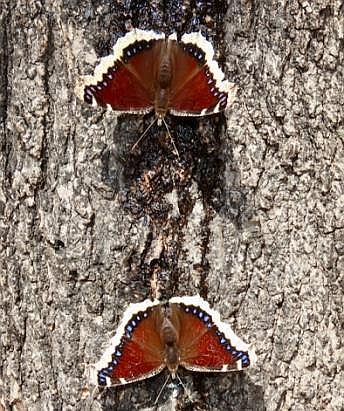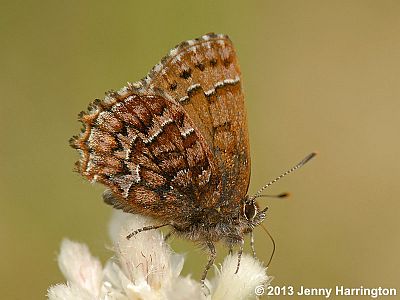What’s Flying Now in New Jersey
March & April
By Wade and Sharon Wander

Mourning Cloak - one of the first of Spring

Eastern Comma - another early flyer
This more-or-less monthly feature is a general guide to the temporal emergence of many species of butterflies found in North Jersey and as such will be of most value to the beginner or novice butterflier.
For daily updates on what is being seen and where, check out the NJ Butterfly Club sightings page and the South Jersey Butterfly Log.
After what every year seems like a punishing winter that will never end, most of us eagerly await the beginning of the butterfly season. What joy to see the first butterfly of the new year! But usually we don’t have to wait until the March 21 arrival of Astronomical Spring to see Mourning Cloak and Eastern Comma. Both species overwinter as adults, and those that survive the long winter emerge on unseasonably warm and mostly-sunny days in early March—and sometimes even late February. More than any other species in North Jersey, these two are harbingers of butterflies yet to come. Look for them along woodland trails during the warmest hours. The sharp-eyed observer may see them perched on bare ground or flush them from basking places among fallen leaves. But often you will see them zipping by a few feet off the ground and sometimes landing on tree trunks—upside down, no less. Occasionally small groups of one or both species will gather at running sap or moisture exuding from tree wounds or recently cut stumps. The Mourning Cloaks and Eastern Comma in the photos have found sap running from holes drilled by a Yellow-bellied Sapsucker.
What Comes Next?
Many species that do not overwinter as adults soon emerge from their pupae, starting with the familiar Cabbage White in mid- to late March. Orange and Clouded sulphurs are next to follow, but in recent years neither has been reported until later in April or even May. The most sought-after member of the white/sulphur group is the Falcate Orangetip. This striking denizen of clearings in forests emerges in early April. The south end of the Summit Trail in Jenny Jump State Forest in Hope Township, Warren County, is well worth a visit in April and May to see this species, along with several other butterflies and a terrific display of spring ephemeral wildflowers. Falcate Orangetip can also be found along the power line in Mercer County Park.
Late March:

Falcate Orangetip

Spring Azure - Male
By late March look for the lovely blue, thumbnail-size Spring Azure on moist dirt or gravel along woodland roads, or nectaring on Spicebush flowers. Although widely distributed, the first individuals are often reported from the Great Swamp NWR.
Early-Mid April:
By mid-April, butterfly activity really ramps up and species are emerging one after another. The active observer bent on seeing as many species as possible may find Tiger, Spicebush, and Black swallowtails; American Copper; Brown, Henry’s, and Pine elfins; Eastern Tailed-Blue; Pearl Crescent; American Lady; Red Admiral; Silver-spotted Skipper; and a trifecta of duskywings (Sleepy, Juvenal’s, and Wild Indigo) before the month is out. Although most of these species are fairly widespread, a few are not. Sleepy D’wing is very local in North Jersey and one of the most reliable places to see it is along Crater Lake Road (aka, Skyline Drive) in the Delaware Water Gap National Recreation Area. (Park at any of the pulloffs along the east side of the road and check the ground and low shrubs for basking individuals.) And while you are there be sure to look for Brown Elfins on or near Lowbush Blueberry growing along the warmer, southeasterly-facing slopes. The only known reliable place in North Jersey to see Henry’s Elfin is in the holly forest at Sandy Hook Gateway National Recreation Area.

Eastern Pine Elfin
Late April:
And we close out April with the emergence of the first broods of Meadow Fritillary, Harvester, White M Hairstreak, and Juniper Hairstreak. Meadows and hayfields in the northwestern counties are the best places to see the smallest of our fritillaries. In some years the vast hayfields on the private Waterwheel Farm in Fredon Township, Sussex County, support hundreds flying low over the grass (though these large numbers would generally occur with later broods); usually at least a few can be seen from the roads. The beautiful green Juniper Hairstreak is regular at Sandy Hook, White Lake Natural Resource Area, Flatbrookville, and other places where Eastern Redcedars are common and early nectar sources such as Cypress Spurge are available. Harvester occurs at several reliable sites (Thompson Park, Flatbrook-Roy) but White M Hairstreak really can’t be pinned down, appearing only now and then and here and there—so carefully check out any hairstreak you see! Current sightings of these and other species throughout the season are posted on the club website under Northern NJ Butterfly Sightings.

Juniper Hairstreak
Some Final Thoughts:
Just a few other things to bear in mind while searching for butterflies:
Most species emerge earlier in Monmouth and Mercer counties, for example, than at the higher elevations of the more northern counties. So, you might see freshly emerged Juniper Hairstreaks in mid-April at Sandy Hook but may have to wait until late April or even early May to see any at the Flatbrookville area of Delaware Water Gap NRA. And all bets are off farther downstate, where you can find many more species on the wing in late winter or early spring and some, like Frosted and Hoary elfins, Hessel’s Hairstreak, and sundry azures, that occur only in the southern counties.
For those folks who keep year lists (or, in the extreme form of the listing disease— monthly lists) a few species fly only in the spring, so if you don’t see Falcate Orangetip, the elfins, Juvenal’s Duskywing, or Sleepy Duskywing by mid-June or so you’ll have to wait until the following spring. Since the other species usually have multiple broods, missing them in the spring is not the major disappointment it is with the single-spring- brood species.
Year-to-year variation in species abundance is to be expected. So, some years Red Admiral and American Lady may be common or even abundant and other years decidedly uncommon.
Lastly, while searching for butterflies do not enter private property without permission from the owner lest we butterfliers become unwelcome. So, in these situations please make your observations from the edges of public roads.